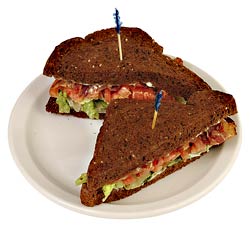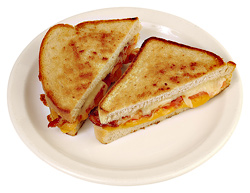Like kids realizing that Santa is a fantasy, gourmands need to adjust to a few lifestyle reassessments this holiday season, if the headlines are to be believed. Foie gras has fallen under Hollywood’s disapproving gaze, Iranian sturgeon are threatened with extinction, and the Ivory Coast turmoil may soon put a crimp in our holiday chocolate binge. But has Seattle’s cuisine scene been affected?
First, foie gras, which sounds a lot better than “fat liver,” has met its match. In late September, California Gov. Arnold “Terminator” Schwarzenegger signed a law requiring the Sonoma Foie Gras farm, one of two U.S. producers of the delicacy, to develop a more “humane” feeding system by 2012 or face an in-state ban on the product. Activists cheered and foodies sneered, but the delicacy didn’t disappear.
Michael Ginor, co-owner of America’s other foie gras farm in Hudson Valley, N.Y., thinks he’ll sell more fat liver in the short term. “When these animal-rights activists walk around telling everyone what to do, suddenly people who’ve never heard of foie gras get exposed, and it increases the marketplace.” But he thinks Sonoma will likely fold after 2012 and doesn’t consider his own company invulnerable, either. Hudson Valley foie gras is produced like Sonoma’s: Grain is pushed into the duck’s esophagus through a tube three times a day until the animal’s liver weighs roughly a pound and a half (up to a third the bird’s total weight). Careful USDA examinations of each duck pre- and postmortem are intended to prevent “esophagus damage and suffering,” but stuffing is stuffing: “There’s no other way to make foie gras. There has been nothing in 5,000 years, and there will be nothing in the next 7,000,” Ginor says.
Leaders of the Seattle restaurant community aren’t deeply concerned. Rover’s owner and chef Thierry Rautureau says, “The few people I’ve heard mention it have shrugged their shoulders. We have plenty of other social problems to worry about. I choose to worry about the people who don’t have any food on their table.” Maximilien chef Eric Francy considers the activism hypocritical. “Why don’t they stop eating chicken, too? Their conditions aren’t much different,” he says.
Despite a bevy of restaurants around town unveiling foie gras–inclusive holiday menus, so far local activists have kept their picket signs on the shelf. Dave Bemel of Seattle-based Action for Animals says his team is focused on promoting veganism and crusading on a PETA-inspired campaign against KFC’s archaic slaughterhouse practices. The Northwest Animal Rights Network has a crammed calendar of protests on its Web site, including a recent anti–foie gras march in California, but nothing up and coming for the locals.
Unlike the threat to foie gras, the caviar dilemma affects everyone in the market for luscious salty fish eggs this holiday season. In October, the Environmental Protection Agency declared beluga sturgeon “threatened with extinction.” The result: skyrocketing prices and tightening supplies. The U.S. Fish and Wildlife Service is developing rules to cut off the market for illegally caught beluga sturgeon roe by tightening importation regulations. The rule was delayed but should become effective in January.
Dale and Betsy Sherrow, owners of the Seattle Caviar Company (2833 Eastlake Ave. E., 206-323-3005), are “100 percent in favor of” the legislation. Dale says he and Betsy work closely with the U.S. Fish and Wildlife service to help prevent illegal products from coming through the local market.
Holly Smith, owner of Cafe Juanita in Kirkland, is against any continued importation of beluga caviar. “The U.S. is the largest importer of beluga in the world, and that promotes poaching and the devastation of a species—I cannot fathom how I could serve it in all good conscience.” Smith was one of nearly 200 chefs nationally who signed a letter to U.S. Department of the Interior Secretary Gale Norton in 2002, urging a ban on U.S. importation as well as international trade of beluga sturgeon and caviar.
Nevertheless, beluga caviar still occupies celebrity status in the gourmet food world. It’s gracing headlines and hobnobbing with the wealthy (or those devotees who’ll still buy Iranian beluga caviar from the Seattle Caviar Company at $198/ounce, up considerably from last year’s $115/ounce, according to Betsy Sherrow).
Those torn between conscience and cuisine this holiday season needn’t re-invent their dinner plans entirely. Aquacultured (farmed) sturgeon provide a palette of flavors similar to the dynamic Caspian Sea trio of beluga, osetra, and sevruga. The aquaculture alternative is one that the Sherrows and Smith agree on. It is also a big reason for the delayed rules, as the U.S. Fish and Wildlife Service is conducting further research into the effects of aquaculture on the Caspian beluga population.
The Seattle Caviar Company, having worked with aquaculture farms for the past 10 years, suggests California white sturgeon roe as a flavorful substitute for the midprice Iranian osetra and a Yellowstone River paddlefish caviar to stand in for Russian sevruga, the least expensive (and most available) of Old World caviar. Even Cafe Juanita will feature California Sterling Caviar on its New Year’s Eve menu.
Chocolate is a year-round comfort but a holiday cure-all. A decadent luxury. It’s a romantic gift. Chocolate is . . . a centerpiece for political turmoil? The explosion of violence in early November between Ivory Coast loyalists under President Laurent Gbagbo, rebel factions in the north, and France spiked the cost of cocoa and may have worried a few candy bar junkies before this season of sweets got under way.
According to data from the World Cocoa Organization, cocoa prices shot up in the week following the turmoil. Exporters at the Ivory Coast’s two main ports, Abidjan and San Pedro, shuttered their doors, and roadblocks prevented supply trucks from reaching the ports. Sure, the serious price spikes lasted only a few days, and the market quickly resumed exportation. But the Ivory Coast supplies a crucial 40 percent of the world’s cocoa, and the peak of its harvest occurs between October and January. Nestlé, the world’s largest cocoa buyer, tries to protect itself by purchasing on the futures market. But even Nestlé can’t protect itself from civil unrest that destroys the cocoa crop or holds its fields for ransom.
For this year, at least, chocoholics seem unlikely to find themselves short of a fix. Locally, Dylan Bigelow, production manager of Fran’s Chocolate (www.frans chocolates.com, 800-422-FRAN), says he purchased chocolate from before and after the turmoil, observing no increase in price. “It’s not like cocoa beans are the only thing that’s going to affect the cost of our product. We adjust our prices annually and also take into account the price of oil, [packaging], and milk,” he says.
Though the headlines paint a dramatic scene of duck-hugging actors, caviar-free cocktail parties, and cocoa prices ascending beyond the common man’s pocketbook, here in Seattle, the winter holidays are shaping up to be as luxurious as always for those who desire it so.







